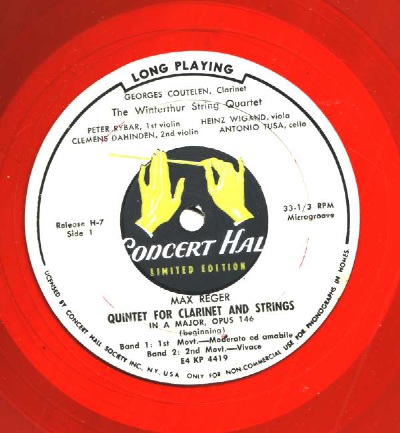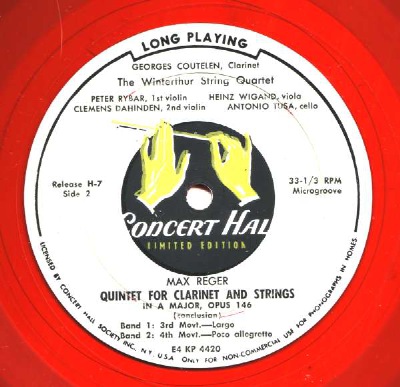 | 
Max Reger, Quintette pour clarinette et quatuor à cordes en la majeur, Op. 146, Georges Coutelen, Quatuor à cordes de Winterthur, Concert-Hall Release CHS H7
 Max Reger compose cette oeuvre en 1916, peu avant son décès prématuré, alors qu'il n'est âgé que de 43 ans. Max Reger dédie l'oeuvre à son ami "Prof. Karl Wendling", un pianiste et pédagogue, collègue du compositeur au Conservatoire de Leipzig. L'oeuvre est très complexe. Comme je n'ai pas pu trouver de bonne description en français, je cite la description en anglais parue sur la pochette de ce disque Concert Hall: Max Reger compose cette oeuvre en 1916, peu avant son décès prématuré, alors qu'il n'est âgé que de 43 ans. Max Reger dédie l'oeuvre à son ami "Prof. Karl Wendling", un pianiste et pédagogue, collègue du compositeur au Conservatoire de Leipzig. L'oeuvre est très complexe. Comme je n'ai pas pu trouver de bonne description en français, je cite la description en anglais parue sur la pochette de ce disque Concert Hall:
"[...] No typical analysis could hope to do justice by the work, so complex in its organic structure. [...] The following will suffice unto the broad outlines: There are four movements. The first, Moderato ed amabile, opens in A major with the clarinet giving out the Brahmsian theme that sets the tonal and textural pattern for the whole. Interweaving filigree is heard in the strings. The first violins submit a subsidiary motive in B minor. After a brief Agitato section the second and principal theme is sung Tranquillo by the violins in the major, accompanied in the minor. This is developed elaborately before the ppp close.
The second movement, Vivace, is in D major. The clarinet has the Dolce espressivo melody against the muted pizzicato strings, excepting the viola. A secondary theme also is stated by the clarinet, and there is an extensive development in B flat major in which the first violins take over the earlier role of the violas. There is a pervading impishness until the end, which come very quietly.
The third movement, Largo, is in E major. The introductory eight bars are given over to a statement of the theme by the clarinet. The first violin repeats this, with the clarinet accompanying. The writing is broadly spaced but for the triplets demanded of the lower strings. In a Poco stringendo section the clarinet and first violin play in unison for a while before the clarinet inherits the theme and the strings provide sixteenths behind it. There is a short-lived Agitato interval before the clarinet ends the movement with an echo of the opening theme.
The Finale is one of the most renowned sets of variations in the chamber literature. Overall it is marked Poco allegretto. The theme is pronounced by the first violins in the opening eight bars, Grazioso; the key throughout is again in A major. Variations I and II are ever so subtle mutations of the original theme, as is III to a somewhat more obvious degree. Rapid exchanges between the clarinet and first violin keep IV and V busy. The tempo changes to Vivace in VI, with the first violins offering the melody and the second violins playing a sixth lower while the clarinet flies up and down scales. In VII the Vivace is continued, with even more animated exchanges between the clarinet and first violin and subsequently a duet passage over the soft lower strings. Variation VIII takes us almost but not quite back to the opening tempo; the first violin sings the melody with the second violins a third lower; in the fifth bar the clarinet take over the melody an octave below the first violin. The clarinet and first violin play in unison for the opening four bars of IX, after which there is an Agitato in which the clarinet spins a pretty web around the theme-laden first violin and then vice-versa. Variation X turns Vivace again, and the same tempo holds through XI and XII, with the violins speaking in triplets of sixteens notes and enlisting answers from the clarinet over plucked strings. In XIV, which is a Lento, the first violin provides the theme with the second violin echoing, and the clarinet dominates the remaining pages. A sort of canon involving the clarinet and the first violin is the highlight of XIV. Variation XV is another Vivace, but a bit slower than before; there is considerable dialogue between the clarinet and first violin. Then the clarinet's sixteenth notes are taken up by the lower strings and the two most voluble instruments are reduced to journeyman accompaniment. The XVI is superficially similar, with the violins playing a minor third apart and plenty of octave writing in the other strings. In XVII the violins stay an octave apart; the first violin play little more than phrases in sixteenths; the clarinet has a hint of the melody but mostly just decorative passages. In XVIII there is another stretch of dialogue, with the clarinet opening. Variation XIX is a Sostenuto, with the clarinet proffering what is left of the theme and the violins and violas backing up the solo instrument with syncopated unison. The final variation - XX - has the first violins and the clarinet separated by an octave, but this time the clarinet part is written an octave lower than the first violins instead of an octave above as was the case in XIX. There is an extended question and answer section, and the instrumental conversation wears itself out before the work ends, slowly but sunnily, in the same A major whence it began. [...]" James Lyons, Concert Hall Release H-7
La partition peut être librement téléchargée sur la page correspondante de l'IMSLP.
Dans cet enregistrement le clarinettiste Goerges Coutelen (1914-1987) est accompagné par le Quatuor à cordes de Winterthur. Le disque utilisé pour cette restauration est un vinyle rouge translucide Concert Hall Release H7, dont la première parution est mentionnée dans le 3e supplément du WERM 1953-1955 - CHS 1244 et o.n. CHS-H 7 (o.n. = old number, i.e. same recording has been renumbered in the same country). Je n'ai pas pu trouver de données plus exactes sur la date d'enregistrement.
Mon disque est dans un état bon à passable: j'ai essayé de le restaurer le mieux possible, sans altérer le son de la clarinette. Il reste de nombreux défauts de surface audibles, surtout dans les deux premiers mouvements.
Voici donc...
Max Reger, Klarinettenquintett in A-Dur fuer Klarinette, 2 Violinen, Viola und Violoncello, Op. 146, Georges Coutelen, Streichquartett Winterthur (Peter Rybar, Clemens Dahinden, Violine, Antonio Tusa, Cello, Oskar Kromer, Bratsche), Concert-Hall Release CHS H7 (1. Moderato ed amabile 09:49:500, 2. Vivace 05:20, 3. Largo 09:06, 4. Poco allegretto 09:13)
que vous pouvez obtenir en...
______________________________CLIQUANT_ICI______________________________
 Concert-Hall Release CHS H7 -> WAV -> moyen DeClick avec ClickRepair, de nombreuses réparations manuelles -> FLAC Concert-Hall Release CHS H7 -> WAV -> moyen DeClick avec ClickRepair, de nombreuses réparations manuelles -> FLAC
4 fichiers FLAC, 2 fichiers CUE (*) et 1 fichier TXT dans 1 fichier ZIP
Radiodiffusion -> WAV -> FLAC
(*) 1 fichier CUE pour les fichiers décomprimés en WAV et 1 fichier CUE pour les fichiers comprimés FLAC, si votre logiciel peut utiliser directement les fichiers FLAC.
P.S. Il y a une erreur dans les fichiers CUE et PDF, que j'ai constaté trop tard: il s'agit de Georges Coutelen, et non de Roger Coutelen.

|  |

